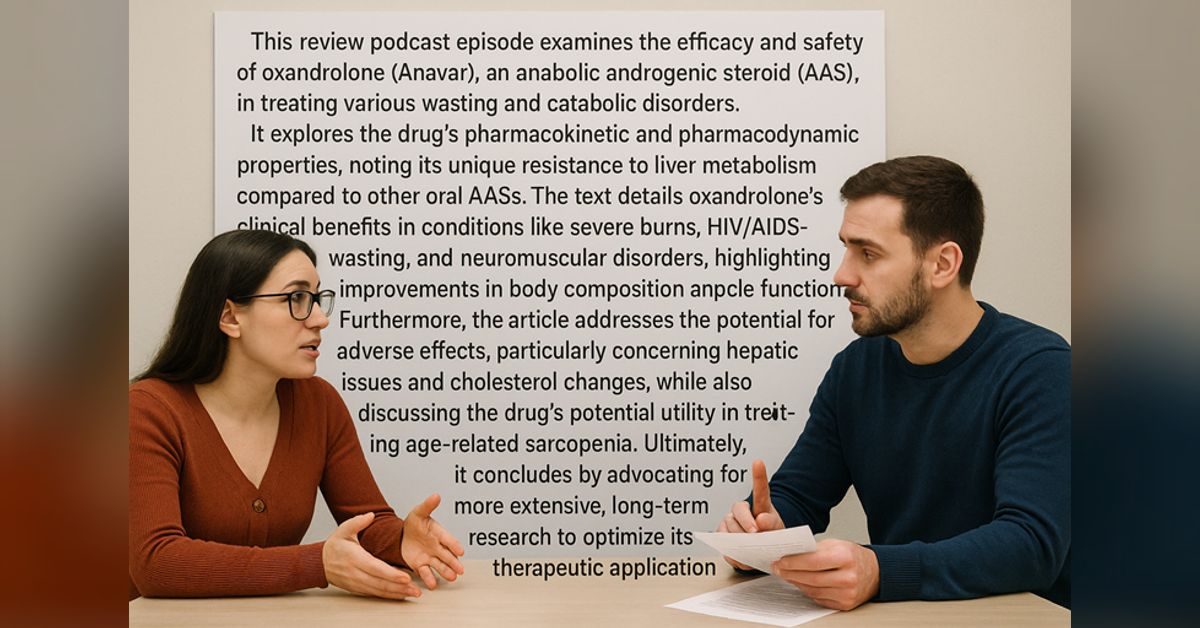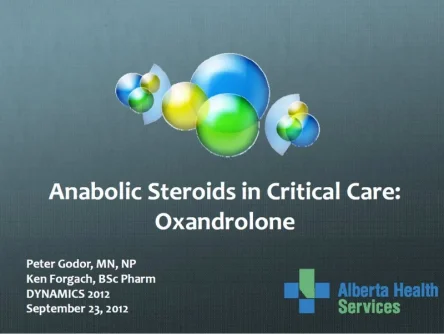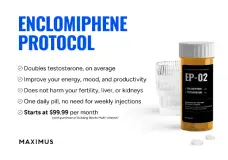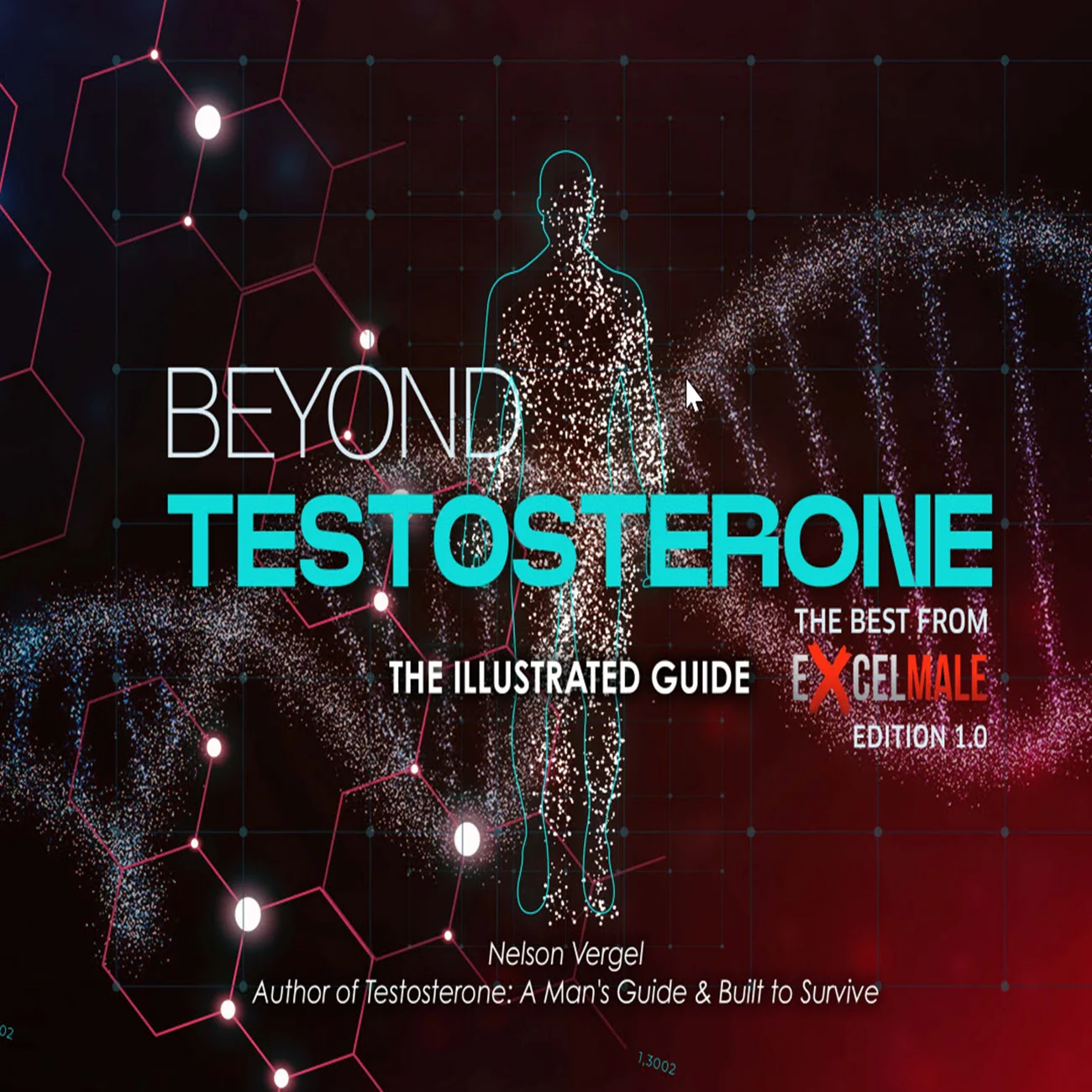Here is a presentation for download only for registered members:


 www.podbean.com
www.podbean.com
Key Facts:
Main Themes & Important Ideas/Facts:
Main Themes & Important Ideas/Facts:
Main Themes & Important Ideas/Facts:


Oxandrolone (Anavar) Efficacy and Safety: Review of Data
This review podcast episode examines the efficacy and safety of oxandrolone, an anabolic androgenic steroid (AAS), in treating various wasting and catabolic disorders. It explores the drug's pharmacokinetic and pharmacodynamic properties, noting its unique resistance to liver metabolism compared...
The Anabolic Androgenic Steroid Oxandrolone in the Treatment of Wasting and Catabolic Disorders
Source: Excerpts from "The Anabolic Androgenic Steroid Oxandrol.pdf" by Rhonda Orr and Maria Fiatarone Singh, Drugs 2004; 64 (7): 725-750.1. Overview of Oxandrolone and Anabolic Androgenic Steroids (AASs)
Oxandrolone is an anabolic androgenic steroid (AAS) that has been utilized for over three decades in clinical settings to promote anabolism, particularly in patients suffering from chronic wasting conditions. It is derived from testosterone and possesses both anabolic (protein synthesis, nitrogen retention, muscle growth) and androgenic (development of male sexual characteristics) activities, although oxandrolone is noted for its "marked anabolic activity and few androgenic effects" and a "high anabolic : androgenic ratio (10 : 1)" compared to testosterone and methyltestosterone.Key Facts:
- FDA Approval: In the US, oxandrolone is the "only AAS that is US FDA-approved for restitution of weight loss after severe trauma, major surgery or infections, malnutrition due to alcoholic cirrhosis, and Duchenne’s or Becker’s muscular dystrophy."
- Chemical Configuration: Unlike other orally administered C17α-alkylated AASs, oxandrolone has a "novel chemical configuration" which confers "resistance to liver metabolism" and contributes to its "marked anabolic activity."
2. Clinical Efficacy of Oxandrolone
The review provides "strong evidence of its clinical efficacy" across a range of conditions characterized by muscle wasting and catabolism.Main Themes & Important Ideas/Facts:
- Broad Application: Oxandrolone has shown benefits in:
- HIV/AIDS-associated wasting
- Severe burn injury
- Trauma following major surgery
- Neuromuscular disorders (e.g., Duchenne’s or Becker’s muscular dystrophy, amyotrophic lateral sclerosis, inclusion body myositis, spinal cord injury)
- Alcoholic hepatitis
- Chronic illnesses leading to muscle wasting
- Miscellaneous disorders (e.g., hereditary angioedema, dyslipidaemia, lipodermatosclerosis, and in elderly patients with chronic diseases).
- Key Improvements Observed:
- Body Composition: "Improvements in body composition, muscle strength and function, status of underlying disease or recovery from acute catabolic injury and nutritional status are significant in the vast majority of well designed trials." Specifically, studies reported increases in body weight, lean body mass, and muscle protein synthesis, alongside decreases in fat mass. For instance, in burn injury patients, oxandrolone led to "↓ weight loss (4.5% less weight loss with OX)" and "↑ bodyweight (4kg greater increase with OX)."
- Muscle Strength and Function: Studies consistently showed enhanced muscle strength and improved functional status (e.g., increased functional independence, better performance scores, improved walking distance, and respiratory function).
- Recovery and Survival: In acute catabolic states like severe burn injury, oxandrolone treatment was linked to "faster healing," "↓ length of hospital stay," and "improved mortality and outcome." In alcoholic hepatitis, it led to "↑ survival at 6mo" and "↓ malnutrition."
- Combination Therapy: Several studies, particularly in HIV/AIDS-associated wasting, demonstrated that combining oxandrolone with progressive resistance training provided "significantly greater improvements to bodyweight, nitrogen retention, lean body mass and bone mineral content, as well as reduced fat mass."
3. Toxicity and Adverse Effects
Compared to other C17α-alkylated AASs, oxandrolone appears to have a more favorable safety profile, particularly regarding hepatotoxicity.Main Themes & Important Ideas/Facts:
- Hepatic Effects:
- Reduced Hepatotoxicity: "Oxandrolone appears not to exhibit the serious hepatotoxic effects (jaundice, cholestatic hepatitis, peliosis hepatis, hyperplasias and neoplasms) attributed to the C17α-alkylated AASs."
- Transient Enzyme Elevations: The "most commonly documented adverse effects are transient elevations in transaminase levels and reductions in high density lipoprotein cholesterol level." These elevations are generally asymptomatic and reversible upon drug withdrawal. Only "Three studies (7%) reported the need to discontinue oxandrolone treatment because of elevated transaminase levels."
- Distinction from other AASs: The review highlights that reports of hepatotoxicity from C17α-alkylated AASs "based solely on increased AST and ALT levels may be overestimated" as these can also result from muscle damage due to intense training.
- Androgenic Effects:
- Low Incidence: Androgenic adverse effects (e.g., facial hair growth, acne, deepened voice, clitoromegaly) were "reported in only 14 individuals" out of approximately 1000 patients across 27 studies that assessed them, despite a significant proportion of studies including women. This "low incidence" is attributed to oxandrolone's "more favourable ratio of anabolic : androgenic potency."
- Cholesterol Alterations:
- HDL Reduction: The predominant effect on cholesterol was to "lower high density lipoprotein (HDL) cholesterol... by 36–47% below baseline values," which is comparable to other AASs. Some studies also reported elevations in total or low density lipoprotein (LDL) cholesterol.
- Long-term Concern: The long-term consequences of these cholesterol changes for cardiovascular health remain a concern, especially for chronic use or in patients with pre-existing cardiovascular risk factors.
- Other Adverse Effects:
- "Psychological/behavioural changes" (e.g., mood lability, agitation, irritability, anxiety) were noted in 13 patients.
- "Oedema" was observed in some elderly subjects, particularly those with congestive heart failure or COPD.
- No reported cases of prostate cancer related to oxandrolone use in the reviewed studies, though longer follow-up is suggested.
4. Potential Utility in Sarcopenia
The authors identify sarcopenia (age-related loss of muscle mass and function) as an area of "great potential" for oxandrolone, despite not yet being formally studied in this specific population.Main Themes & Important Ideas/Facts:
- Addressing Causal Factors: Oxandrolone is an "attractive candidate" for sarcopenia treatment because it may influence several contributing factors, including:
- Decreasing visceral fat stores and total body fat.
- Increasing protein synthesis rate in skeletal muscle.
- Increasing dietary energy and protein intake.
- Improving nitrogen retention.
- Increasing muscle function and physical activity levels.
- Substituting for losses of natural androgen and estrogen hormones.
- Broader Benefits: The authors hypothesize that reduced visceral fat could lead to favorable changes in catabolic influences (e.g., cortisol, leptin) and improved anabolic hormone action (growth hormone, IGF-1, insulin).
- Need for Further Research: Despite promising theoretical and observed benefits in similar conditions, there is a "clear need" for:
- Long-term studies (>1 year) focusing on safety and efficacy in sarcopenia.
- Better dosage titration.
- Exploration of intermittent vs. continuous therapy.
- Studies combining oxandrolone with other anabolic stimuli like resistance training and nutritional supplementation.
- Research on reducing catabolic stimuli concurrently.
- Studies specifically in women, especially elderly women, given testosterone's androgenic limitations for this demographic.
5. Conclusion
Oxandrolone presents a promising therapeutic option for various catabolic and wasting conditions due to its "oral route of administration," "high anabolic : androgenic potency," and "lack of evidence of serious or irreversible hepatic toxicity." While generally well-tolerated, the transient elevations in transaminase levels and reductions in HDL cholesterol are important considerations for long-term use. The review strongly advocates for further research, particularly in the context of sarcopenia, to refine optimal risk-benefit ratios and explore its utility in women.What is oxandrolone and how does it differ from other anabolic androgenic steroids (AASs)?
Oxandrolone is a synthetic anabolic androgenic steroid (AAS) that has been in clinical use for over 30 years. It is derived from testosterone but has a unique chemical structure that makes it relatively resistant to liver metabolism, unlike many other orally administered C17α-alkylated AASs. This distinct configuration contributes to its marked anabolic activity with fewer androgenic (masculinizing) effects compared to other AASs, boasting an anabolic:androgenic ratio of approximately 10:1. In the US, it is the only FDA-approved AAS for certain conditions like weight loss after severe trauma, major surgery or infections, malnutrition from alcoholic cirrhosis, and muscular dystrophies.What are the primary medical conditions for which oxandrolone is clinically effective?
Oxandrolone has demonstrated significant clinical efficacy in a variety of conditions characterized by muscle wasting and catabolism. These include:- Acute Catabolic Disorders: Such as severe burn injury and trauma after major surgery, where it helps attenuate hypermetabolic response, enhance muscle protein synthesis, decrease weight and nitrogen loss, and improve healing time and functional recovery.
- Chronic Catabolic Disorders: Including alcoholic hepatitis, where it improves body composition, liver function, and survival rates, and potentially chronic lung disease (though more controlled trials are needed).
- HIV/AIDS-Associated Wasting: Leading to improvements in body composition, muscle strength, and nutritional status.
- Neuromuscular Disorders: Including Duchenne’s or Becker’s muscular dystrophy, and amyotrophic lateral sclerosis, showing benefits in body composition, muscle function, and pulmonary function.
- Miscellaneous Disorders: It has also shown utility in conditions like hereditary angioedema, dyslipidaemia, and in promoting anabolism in the elderly with chronic diseases.
How does oxandrolone promote anabolism and muscle growth?
Oxandrolone promotes anabolism through both direct and indirect mechanisms. Directly, it increases muscle mass by stimulating protein synthesis and improving the efficient utilization of amino acids. It also increases androgen receptor (AR) expression in skeletal muscle. Indirectly, it acts by antagonizing the glucocorticoid receptor, thereby inhibiting protein catabolism. It also enhances skeletal muscle protein synthesis by inducing hepatic insulin-like growth factor (IGF)-1 production and appears to suppress myostatin protein expression.What are the common and less common adverse effects associated with oxandrolone use?
While generally well tolerated, oxandrolone can have adverse effects. The most commonly documented are:- Hepatic Effects: Transient elevations in transaminase levels (liver enzymes) are the most frequent, particularly with higher dosages or prolonged use, but these are typically asymptomatic and reversible upon drug withdrawal. Unlike other C17α-alkylated AASs, oxandrolone appears not to exhibit serious hepatotoxic effects like jaundice, cholestatic hepatitis, peliosis hepatis, hyperplasias, or neoplasms.
- Cholesterol Alterations: The predominant effect is a reduction in high-density lipoprotein (HDL) cholesterol levels, and sometimes elevations in total or low-density lipoprotein (LDL) cholesterol. The long-term cardiovascular implications of these changes are not fully understood due to the relatively short duration of most studies.
- Androgenic Effects: These are less common with oxandrolone due to its favorable anabolic:androgenic ratio, but can include facial hair growth, acne, alopecia, deepened voice, increased libido, and clitoromegaly, particularly in women.
- Psychological/Behavioral Changes: Transient mood lability, agitation, irritability, anxiety, and aggression have been reported in a small percentage of patients.
- Other Effects: Oedema (swelling) has been noted, particularly in elderly subjects with conditions like heart failure or COPD.
Is oxandrolone associated with serious long-term liver damage like other AASs?
Unlike many other C17α-alkylated AASs, oxandrolone is reported to be generally well tolerated regarding liver health. The more serious forms of hepatotoxicity associated with other AASs, such as peliosis hepatis, adenomas, and hepatocellular carcinoma, have not been definitively linked to oxandrolone. The observed hepatic adverse effects with oxandrolone are predominantly asymptomatic and reversible elevations in transaminase levels, which normalize upon discontinuation of the drug. However, continuous monitoring of liver function is prudent, especially in patients with pre-existing liver conditions.How does oxandrolone affect body composition in patients?
Oxandrolone consistently shows significant improvements in body composition. It leads to:- Increased Lean Body Mass: This includes increases in overall bodyweight, muscle mass, and body cell mass.
- Improved Nitrogen Retention: Indicating enhanced protein synthesis and reduced protein breakdown.
- Decreased Fat Mass: Notably, it has been shown to reduce visceral fat (fat around internal organs) and subcutaneous fat.
- Enhanced Bone Mineral Content: In some studies, it contributed to improvements in bone health, such as increased femoral cortical bone area.
What is sarcopenia and how might oxandrolone be useful in its treatment?
Sarcopenia is the involuntary loss of skeletal muscle mass and function, commonly associated with aging, disuse, and chronic conditions. It leads to muscle weakness, impaired mobility, increased falls, disability, and higher mortality risk. While oxandrolone has not yet been specifically studied for sarcopenia in the elderly, its known anabolic effects make it a promising candidate. It has been shown to:- Decrease visceral fat stores.
- Increase protein synthesis rates in skeletal muscle.
- Improve dietary energy and protein intake.
- Enhance nitrogen retention.
- Increase muscle function and physical activity levels.
- Potentially substitute for losses of natural androgen and estrogen hormones, which contribute to sarcopenia.
What are the future research directions for oxandrolone, especially concerning chronic conditions and aging?
Future research on oxandrolone needs to focus on refining its optimal risk:benefit ratios, particularly for widespread clinical acceptance in chronic wasting conditions and sarcopenia. Key areas include:- Long-Term Safety and Efficacy Studies: Conducting studies lasting over one year to fully understand the long-term impact on safety and efficacy in various clinical populations.
- Dosage Titration: Better understanding and titrating dosages to minimize adverse effects while maximizing benefits.
- Intermittent vs. Continuous Therapy: Exploring the effectiveness and safety of intermittent or short-term treatment regimens versus continuous exposure.
- Combination Therapies: Investigating its synergistic effects when combined with other anabolic stimuli, such as progressive resistance training or nutritional supplementation.
- Addressing Catabolic Influences: Exploring how oxandrolone can contribute to creating a more favorable anabolic:catabolic environment by reducing catabolic factors like cytokines, cortisol, and visceral fat depots.
- Studies in Women and the Elderly: A particular need exists for more extensive research in women and the very elderly, who represent a significant portion of individuals susceptible to sarcopenia and could benefit from effective anabolic agents.
Last edited:













